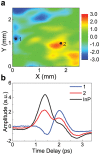Imaging molecular adsorption and desorption dynamics on graphene using terahertz emission spectroscopy
- PMID: 25116593
- PMCID: PMC4131213
- DOI: 10.1038/srep06046
Imaging molecular adsorption and desorption dynamics on graphene using terahertz emission spectroscopy
Abstract
Being an atomically thin material, graphene is known to be extremely susceptible to its environment, including defects and phonons in the substrate on which it is placed as well as gas molecules that surround it. Thus, any device design using graphene has to take into consideration all surrounding components, and device performance needs to be evaluated in terms of environmental influence. However, no methods have been established to date to readily measure the density and distribution of external perturbations in a quantitative and non-destructive manner. Here, we present a rapid and non-contact method for visualizing the distribution of molecular adsorbates on graphene semi-quantitatively using terahertz time-domain spectroscopy and imaging. We found that the waveform of terahertz bursts emitted from graphene-coated InP sensitively changes with the type of atmospheric gas, laser irradiation time, and ultraviolet light illumination. The terahertz waveform change is explained through band structure modifications in the InP surface depletion layer due to the presence of localized electric dipoles induced by adsorbed oxygen. These results demonstrate that terahertz emission serves as a local probe for monitoring adsorption and desorption processes on graphene films and devices, suggesting a novel two-dimensional sensor for detecting local chemical reactions.
Figures





Similar articles
-
Adsorption energy of oxygen molecules on graphene and two-dimensional tungsten disulfide.Sci Rep. 2017 May 11;7(1):1774. doi: 10.1038/s41598-017-01883-1. Sci Rep. 2017. PMID: 28496178 Free PMC article.
-
Plasmon enhanced terahertz emission from single layer graphene.ACS Nano. 2014 Sep 23;8(9):9089-96. doi: 10.1021/nn5025237. Epub 2014 Aug 25. ACS Nano. 2014. PMID: 25137623
-
Nonlinear Terahertz Absorption of Graphene Plasmons.Nano Lett. 2016 Apr 13;16(4):2734-8. doi: 10.1021/acs.nanolett.6b00405. Epub 2016 Mar 18. Nano Lett. 2016. PMID: 26978242
-
Molecular adsorption on graphene.J Phys Condens Matter. 2014 Nov 5;26(44):443001. doi: 10.1088/0953-8984/26/44/443001. Epub 2014 Oct 7. J Phys Condens Matter. 2014. PMID: 25287516 Review.
-
Photosensitive graphene transistors.Adv Mater. 2014 Aug 20;26(31):5239-73. doi: 10.1002/adma.201400349. Epub 2014 Apr 8. Adv Mater. 2014. PMID: 24715703 Review.
Cited by
-
High throughput secondary electron imaging of organic residues on a graphene surface.Sci Rep. 2014 Nov 13;4:7032. doi: 10.1038/srep07032. Sci Rep. 2014. PMID: 25391356 Free PMC article.
-
Sensitive Characterization of the Graphene Transferred onto Varied Si Wafer Surfaces via Terahertz Emission Spectroscopy and Microscopy (TES/LTEM).Materials (Basel). 2024 Mar 26;17(7):1497. doi: 10.3390/ma17071497. Materials (Basel). 2024. PMID: 38612011 Free PMC article.
-
Adsorption energy of oxygen molecules on graphene and two-dimensional tungsten disulfide.Sci Rep. 2017 May 11;7(1):1774. doi: 10.1038/s41598-017-01883-1. Sci Rep. 2017. PMID: 28496178 Free PMC article.
References
-
- Ren L. et al. Terahertz and infrared spectroscopy of gated large-area graphene. Nano Lett. 12, 3711–3715 (2012). - PubMed
-
- Schedin F. et al. Detection of individual gas molecules adsorbed on graphene. Nat. Mater. 6, 652–655 (2007). - PubMed
-
- Ferrari A. C. & Basko D. M. Raman spectroscopy as a versatile tool for studying the properties of graphene. Nat. Nano. 8, 235–246 (2013). - PubMed
-
- Srivastava A. et al. Novel liquid precursor-based facile synthesis of large-area continuous, single, and few-layer graphene films. Chem. Mater. 22, 3457–3461 (2010).
Publication types
LinkOut - more resources
Full Text Sources
Other Literature Sources

